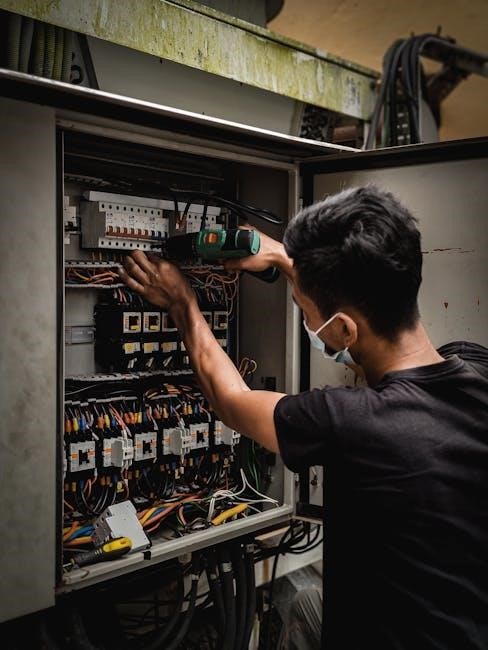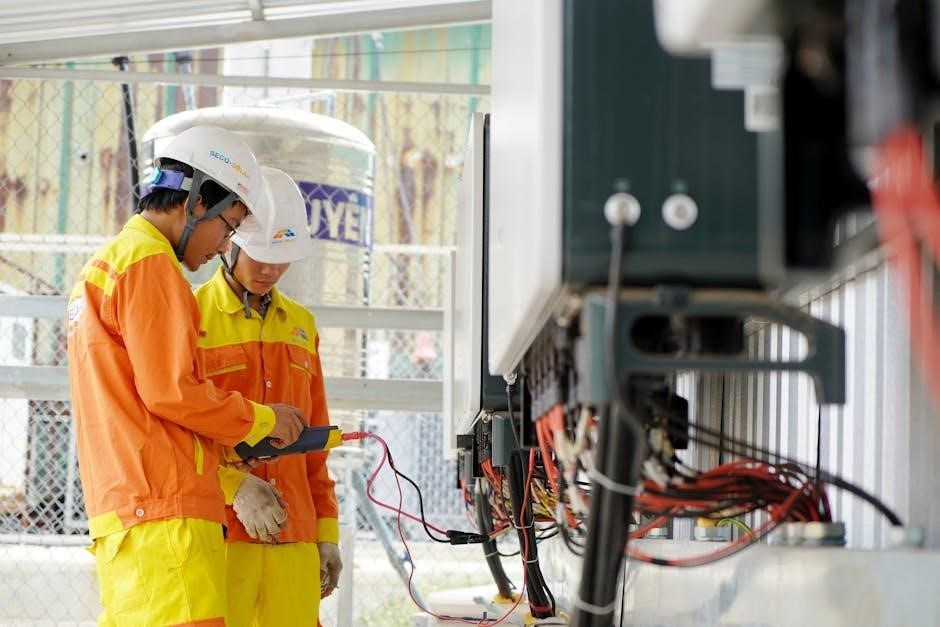Stanley FatMax Professional Power Station Owners Manual: A Comprehensive Guide
Welcome! This guide provides comprehensive information for your Stanley FatMax Professional Digital Power Station. Inside, you’ll find instructions, safety measures, and troubleshooting tips. Familiarize yourself with its features to maximize functionality and ensure safe operation.
The Stanley FatMax Professional Power Station is a versatile tool designed to provide portable power for a variety of applications. Whether you need to jump-start your car, inflate tires, or power electronic devices, this power station is engineered to meet your needs. This robust device combines jump-starting capabilities with an air compressor and AC/DC outlets, making it an essential companion for emergencies, outdoor adventures, and professional use.
This power station is equipped with a digital display for easy monitoring of battery status and other important information. Its rugged construction ensures durability and reliability in demanding conditions. Before using your Stanley FatMax Power Station, it is crucial to thoroughly read this manual to understand its features, safety precautions, and operating instructions. Proper usage will extend the lifespan of the product and ensure your safety. This manual covers initial setup, charging procedures, jump-starting guidelines, air compressor operation, and maintenance tips.

Safety Instructions and Precautions
Before operating the Stanley FatMax Professional Power Station, carefully read and understand all safety instructions. Failure to comply with these instructions may result in electric shock, fire, and/or serious personal injury. Always wear appropriate eye protection when using the power station, particularly when jump-starting vehicles or using the air compressor. Ensure the work area is well-ventilated to prevent the build-up of explosive gases. Keep the power station away from water and moisture to avoid electrical hazards.

When jump-starting a vehicle, always follow the step-by-step instructions provided in this manual. Connect the jumper cables in the correct polarity to prevent damage to the vehicle’s electrical system and the power station. Do not attempt to jump-start a vehicle if the battery is frozen. Regularly inspect the power station for any signs of damage, such as cracked housings or frayed wires. If damage is detected, discontinue use and contact a qualified technician for repair. Store the power station in a cool, dry place away from flammable materials.
Initial Setup and Charging
Upon receiving your Stanley FatMax Professional Power Station, carefully unpack all components and inspect them for any shipping damage. The unit is delivered in a partially charged state, so it’s crucial to fully charge it before first use to ensure optimal performance and longevity of the internal battery. Locate the AC charging adapter included with your power station. Connect the adapter to the charging port on the unit, typically located on the rear panel.

Plug the adapter into a standard AC wall outlet. The digital display will illuminate, indicating that the charging process has begun. Allow the power station to charge for the recommended duration specified in this manual, usually around 24 hours, to achieve a full charge. During charging, the display will show the battery’s charge level. Once fully charged, the display will indicate “FULL” or a similar message. Disconnect the charging adapter from the wall outlet and the power station. Your Stanley FatMax Professional Power Station is now ready for use.
Understanding the Digital Display
The digital display on your Stanley FatMax Professional Power Station is the primary interface for monitoring and controlling its functions. Familiarizing yourself with the display’s various indicators and readouts is essential for efficient and safe operation. The display typically features a battery level indicator, represented by a series of bars or a percentage value, showing the remaining charge in the internal battery.

Pay close attention to this indicator to avoid unexpected power depletion during use. The display also indicates the output voltage, showing whether the power station is providing AC (alternating current) or DC (direct current) power. This information is crucial for ensuring compatibility with the devices you intend to power. Additionally, the display might show the current output in amps or watts, allowing you to monitor the power consumption of connected devices. Error messages or warning symbols may appear on the display to alert you to potential issues, such as overload, low battery, or overheating. Refer to the troubleshooting section of this manual for guidance on interpreting and resolving these messages. Understanding the digital display empowers you to effectively manage and maintain your power station.
Jump Starting a Vehicle: Step-by-Step Guide
Jump starting a vehicle with your Stanley FatMax Professional Power Station is a straightforward process, but it requires careful adherence to safety precautions. First, ensure both the power station and the vehicle are turned off. Locate the vehicle’s battery and identify the positive (+) and negative (-) terminals. Connect the red clamp of the jump starter to the positive (+) terminal of the vehicle’s battery;
Next, connect the black clamp to a non-painted metal part of the vehicle’s frame, away from the battery and fuel lines. Double-check that the connections are secure. Turn on the jump starter and attempt to start the vehicle. If it doesn’t start immediately, wait a few minutes and try again. Avoid prolonged cranking, as it can damage both the starter and the power station. Once the vehicle starts, carefully disconnect the black clamp first, followed by the red clamp. Allow the vehicle to run for a while to recharge its battery. If the vehicle fails to start after several attempts, consult a qualified mechanic. Always consult your vehicle’s manual before attempting to jump start.
Using the Air Compressor
The Stanley FatMax Professional Power Station includes a built-in air compressor, perfect for inflating tires, sports equipment, and other inflatable items. Before using the air compressor, make sure the power station is adequately charged. Locate the air compressor hose and nozzle attachments. Select the appropriate nozzle for your intended use and securely attach it to the hose.
Connect the hose to the item you wish to inflate, ensuring a tight seal to prevent air leakage. Turn on the power station and activate the air compressor function. Monitor the pressure gauge to avoid over-inflation, referring to the manufacturer’s recommended pressure for the item you are inflating. Once the desired pressure is reached, turn off the air compressor and carefully disconnect the hose. Store the hose and nozzle attachments in a safe and accessible location. Regularly inspect the hose and connections for any signs of wear or damage. Remember to consult the owner’s manual for specific details and safety precautions related to the air compressor function. Avoid using the air compressor for extended periods, as it may overheat.

Powering Devices with the AC/DC Outlets
The Stanley FatMax Power Station provides convenient AC and DC outlets for powering various electronic devices. The AC outlet allows you to power devices that typically require a standard wall outlet, such as laptops, lights, and small appliances. Ensure the device’s power requirements do not exceed the power station’s AC output capacity. To use the AC outlet, simply plug the device into the outlet as you would with a normal wall socket.
The DC outlet is designed for powering devices that use a 12V DC connection, like car accessories or charging smaller electronics. Check the device’s voltage and polarity to ensure compatibility with the power station’s DC output. Use a compatible DC adapter or cable to connect the device to the DC outlet. Always turn on the power station before plugging in any devices. Monitor the power station’s battery level while using the AC or DC outlets to avoid draining the battery completely. Remember to turn off the power station and unplug devices when not in use.

Maintenance and Storage

Proper maintenance and storage are crucial for prolonging the life of your Stanley FatMax Power Station. Regularly inspect the unit for any signs of damage, such as cracks, loose connections, or frayed cables. Clean the exterior with a soft, damp cloth, avoiding harsh chemicals or abrasive cleaners. Ensure the ventilation openings are free from dust and debris to prevent overheating during operation or charging.
When storing the power station, fully charge the unit before placing it in a cool, dry place away from direct sunlight and extreme temperatures. Store it in an upright position to prevent any potential leaks or damage to internal components. Check the battery level every few months and recharge as needed to maintain optimal performance. Avoid storing the power station for extended periods in a discharged state, as this can reduce battery life. Keep the power station out of reach of children and pets. By following these maintenance and storage guidelines, you can ensure your Stanley FatMax Power Station remains in good working condition for years to come.
Troubleshooting Common Issues
Encountering issues with your Stanley FatMax Power Station? Here’s a troubleshooting guide for common problems. If the unit fails to power on, ensure it’s fully charged. Check the power switch and connections for any damage. If jump-starting a vehicle fails, verify correct cable polarity and secure connections to the battery terminals. A “low voltage” error may indicate a depleted battery requiring recharge. For air compressor malfunctions, inspect the hose and nozzle for blockages. Ensure the compressor is not overheating; allow it to cool before reuse.
If AC/DC outlets are not functioning, check the power switch. A tripped circuit breaker might be the culprit; reset it if necessary. If problems persist, consult the user manual or contact customer support. Avoid disassembling the unit yourself, as this could void the warranty. Before seeking professional help, try these basic troubleshooting steps. Regularly inspect the power station for any physical damage or loose connections. By following these guidelines, you can resolve many common issues and ensure the continued reliable performance of your Stanley FatMax Power Station.
Warranty Information and Support

Your Stanley FatMax Professional Power Station is backed by a limited warranty against defects in materials and workmanship. The warranty period typically extends for one year from the original date of purchase. This warranty covers normal use and does not apply to damage caused by misuse, abuse, neglect, or unauthorized modifications. To make a warranty claim, you must provide proof of purchase and return the defective unit to an authorized service center.
For warranty service or support, contact Stanley FatMax customer service. Their website offers FAQs, troubleshooting guides, and contact information. You can also reach them by phone or email for assistance with product issues. Before contacting support, gather the model number, serial number, and a detailed description of the problem. Keep all original packaging and documentation in case they are needed for the warranty process. Remember that the warranty is only valid for the original purchaser and is non-transferable. Proper maintenance and adherence to the user manual are essential for maintaining warranty coverage and ensuring optimal performance.

